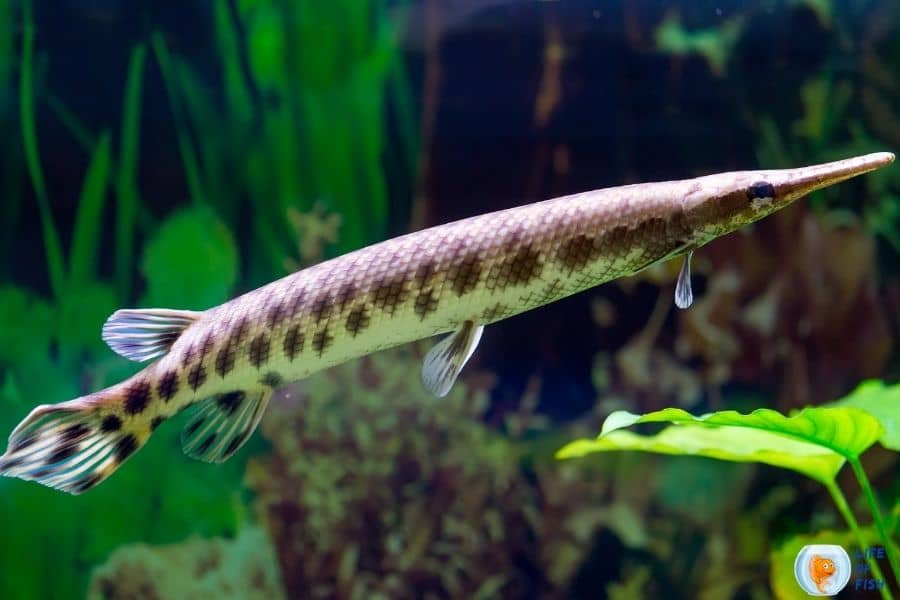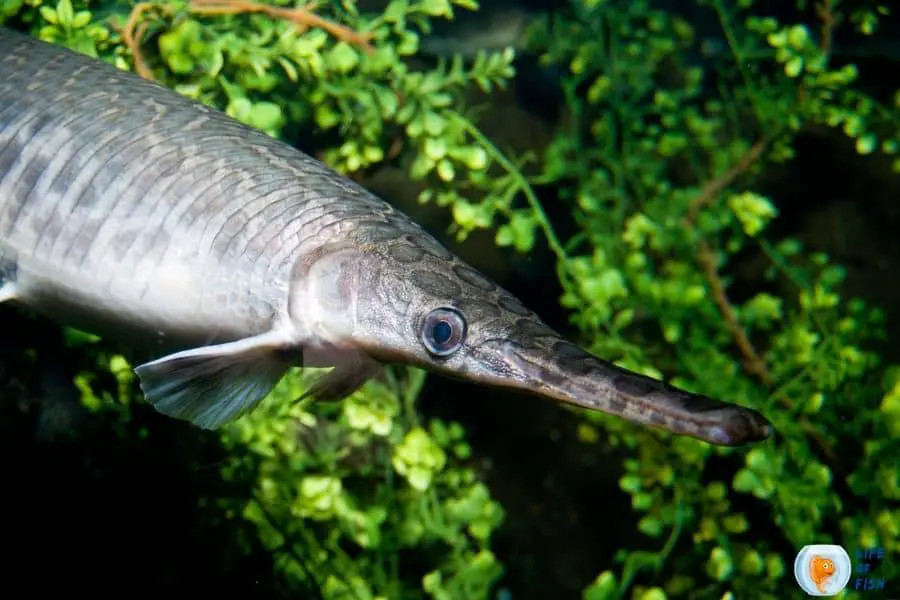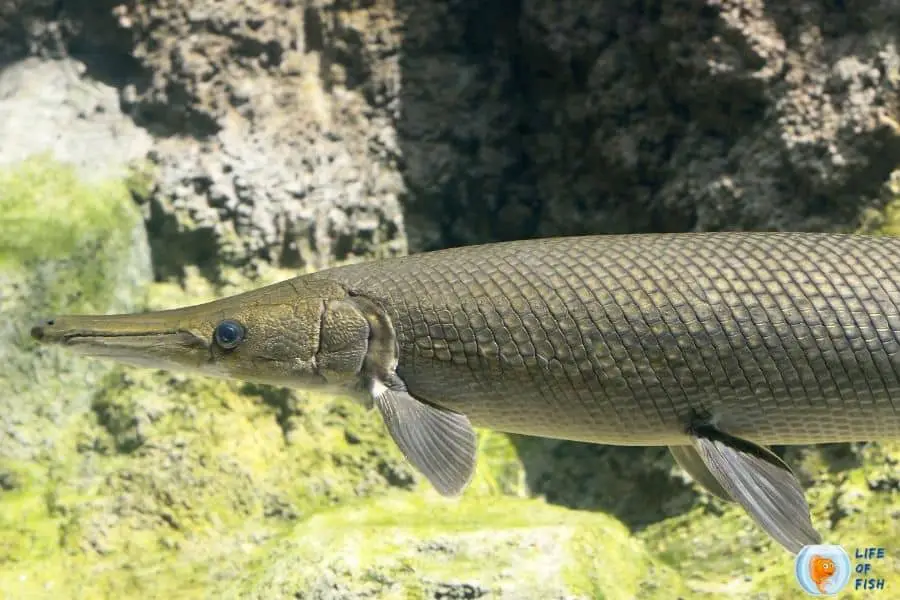Alligator gar is known for its alligator-like heads and razor-sharp teeth. However, they are not related to alligators in any way. There are many other interesting things to talk about Aligator gars, but we will specifically talk about What Do Aligator Gar Eat in this article.

What are they?
Jump To
- 1 What are they?
- 2 What does alligator gar eat?
- 3 How do gar species eat in the wild?
- 4 What do baby alligator gar eat?
- 5 Does alligator gar eat warms?
- 6 How much does alligator gar eat?
- 7 How frequently do they eat?
- 8 Alligator gars predators
- 9 What’s the best bait for alligator gar fishing?
- 10 Do alligator gar attack humans
- 11 Recently Asked Questions
- 12 Conclusion
Alligator gars are freshwater predator fish that can grow to nearly 250 pounds and up to 10 feet in length.
However, they only grow up to 4 feet in aquariums. According to records, the largest alligator gar caught was 279 lb (127 kg) in 1951.
This North American ray-finned fish species is popular among aquarists because of its unique appearance and predatory behavior.
What does alligator gar eat?
The alligator gar is a large, prehistoric-looking fish that can be found in the rivers and lakes of the southeastern United States.
It’s considered one of the most primitive living fishes in North America, meaning it has evolutionary traits that date back to prehistoric times over 100 million years ago.
An alligator gar can grow up to 10 feet long and weigh up to 350 pounds, making it the second-largest living species of freshwater fish in North America.
Alligator gar is an ambush predator who waits for its prey to come close and then attacks them with lightning speed.
Their diet is consists of mainly meat-based food items such as smaller fish and crustaceans.
What does alligator gar eat in the wild
Alligator gar eat fish, frogs, snakes, turtles, and even birds that fly near the water’s surface in the wild.
They can also swallow up small alligators, although adult gars cannot do so easily because of the smaller size of such reptiles.
What does alligator gar eat in an aquarium
They are often fed live or frozen seafood to mimic their natural diet to maintain high muscle mass levels.
Alligator gar needs a lot of nutrition. Therefore, you will have to feed them lots of seafood or freshwater fish to provide enough nutrients.
However, if you keep these fish from their juvenile age, you can train them to eat pellets or flakes so that things get easier for you.
But when you feed them with fish pellets or flakes, be sure to buy high-quality meat-based fish food for your alligator gar.
How do gar species eat in the wild?
Alligator gars are solitary fish that stays a few feet below the surface. They basically float on the water to let the prey think of it like a dead fish.
The unsuspecting fish swims near the alligator gar, and the gar springs forward and captures its prey with a sweeping manner, impaling it on gar’s two rows of sharp fangs.
Alligator gars are opportunistic, voracious ambush predators and primarily piscivores. They usually hunt at night, but they may also hunt in the daytime.
Alligator gars become scavengers in times when they don’t get enough supply of food.
They forage fish like gizzard shad, invertebrates, and waterfowls when they starve without fish.
In brackish waters, these fish heavily depends on blue crabs as food in addition to hardhead catfish.
What do baby alligator gar eat?
Baby alligators grow very quickly and require higher-protein food than what their parents eat.
In order to ensure that they grow at a healthy rate, you will need to feed them foods like brine shrimp and prawns as well as earthworms which are rich in nutrients.
They grow at a fast pace at a young age. An Aligator gar fry will take only about a year to grow into a 24 inches long fish, so their diet changes rapidly over months.
As a rule of thumb, feed the baby fish small meat-based food like brine shrimp, worms, and small invertebrates in the first few months.
But, as they grow on, you will have to acclimate them for pellet food or live or frozen fish.
Many aquarists had success adding small fish like guppies and minnows into their tank to continue their natural predatory behavior in captivity.
But, be careful not to overfeed baby gar species because it will lead to obesity and health issues later in life.

Does alligator gar eat warms?
Alligator gars eat worms but only at a young age.
When they grow up, they give up eating worms and start to eat more fish as their main diet as they are primarily piscivores.
How much does alligator gar eat?
Alligator gar are fish-eating predators that eat fish, frogs, turtles, and other aquatic animals.
They can also prey on small mammals like deer and raccoons. The stomach contents of gar have been found to contain many fish species.
Gars can eat about one-quarter of their body weight in a single day. Since they are opportunistic feeders, they will eat as much as they get near their mouths at night.
How frequently do they eat?
Adult alligator gar has a voracious appetite and often eats twice or more per day. They are opportunistic night predators that predate at night.
They are also piscivores that eat mostly fish as their diet. They can eat live fish that are too large for their mouth or catch fish by chasing them into shallow water, where they are easier to prey upon.
In the wild, populations of Alligator gar will eat whenever they find food on the water surface.
But in captivity, you can feed them twice per day, which is more than enough for these fish. They usually eat on a daily basis, but they can go up to 2 weeks without eating.
Alligator gars predators
Alligator gars have very few natural predators. Usually, they are the primary predators of their habitats.
They are known to prey on much aquatic life such as fish, turtles, frogs, waterfowls, and blue crabs.
Alligator gars also feed on small mammals when they float on the water surface. Known Alligator gar predators are Alligators, large fish, and humans.
Humans are used to fishing these fish for food, as sport fish, and sell them as aquarium fish.
What’s the best bait for alligator gar fishing?
When catching these enormous fish, you will need to have special equipment like a sharp circle hook, steel leader, and slip-float or bobber.
You will also need to have at least a 40-pound test mainline because of the massive size of this fish. As the bait, you will have to consider a relatively large baitfish.
Alligator gars as other gar species will not respond to worms because they are piscivore fish. You will have to attach a fish as the bait to catch these fish. Best baits for Alligator gars are,
- Common carp
- Smallmouth buffalo
- Gizzard shad
- Scaled mullet
These fish species are usually common in freshwater lakes. There are significant populations of these fish in freshwater.
Anglers prefer to use these fish as bait because they are so easy to catch. Further, Alligator gars easily fall for these fish as the bait.
An alligator gar will normally swim off with its prey before trying to consume and swallow it.
When alligator gar fishing, this implies that if you try to set the hook too quickly, you’ll miss out on your chance to catch the gar.
When you see your bobber or glide go down, wait until the fish grabs your bait and begins to devour it before you set the hook.

Do alligator gar attack humans
It is a myth that alligator gar attack humans.
The alligator gar is a large and vicious-looking fish with sharp teeth and powerful jaws. Yet, they are actually quite docile and harmless to humans.
They would rather eat smaller fish than human prey, so there is no reason to fear them in the wild.
However, if you catch an alligator gar, it will try to attack you while trying to save itself. Alligator gars defense themselves when startled or threatened.
Otherwise, they do not pose a threat to humans. Only when anglers attempt to land and handle these enormous, strong fish do they pose a threat to human safety.
Recently Asked Questions
Can you keep alligator gar as a pet?
Many aquarists around the world keep alligator gars as pets. However, these fish require a massive aquarium or a pond to thrive in captivity.
Since providing these requirements is somehow tricky for home aquarists, keeping them as pets is prohibited in some areas.
So, before buying an Aligator gar as a pet for your home aquarium, check with your local authorities first. In some regions, there are legal issues in keeping these fish.
Are alligator gar endangered?
The alligator gar is a critically endangered species that has almost completely disappeared from much of its former range.
Several studies have revealed that the alligator gar is highly vulnerable to overfishing in Alabama, Mississippi, and Louisiana.
It’s rare in Missouri, threatened in Illinois, endangered in Arkansas, and on the verge of extinction in Tennessee, where it’s now listed as an endangered species.
However, due to the adaptation of these fish in the aquarium trade, several Alligator gars survive and thrive in different countries, especially in Japan, where they are highly prized and sought after for private aquaria.
In “Japanese Black Market,” these fish sell for even high as US$40000 per large Alligator gar.
What’s the best time to catch alligator gar?
The alligator gar is a fish that often can be found in lakes, backwaters, bayous, and coastal delta waters.
However, they rarely inhabit brackish waters and marine waters. They spawn in spring, around April in Brackish waters. But it’s best to hunt them during the hot summer months.
During this time, these fish tend to live a few feet below the water’s surface. So, it is easier to catch them during summer.
In July and August, these fish go into deep river bends, so you may not catch these fish during this time.
How long can an alligator gar live out of water?
Usually, most freshwater fish can survive out of the water more time than marine fish. But, Aligator gars can live out of water for about two hours.
This is usually more time than many other fish types, and that is because these fish are enormous in size.
Conclusion
Alligator gars are carnivore fish that eat only meat-based food, primarily fish. They require massive aquariums or ponds to thrive in captivity.
Since providing their ideal habitat is difficult for home aquarists and their rarity, many local authorities banned these fish from keeping in the aquariums.
However, you may find these fish in aquariums occasionally. If you find one, keep in mind that these fish require live or frozen fish to thrive in captivity.
If you are not an experienced aquarist, keeping these fish at home will be pretty challenging.
Read More: Do Orcas Attack Humans? | Are They Vicious As It Sound?
